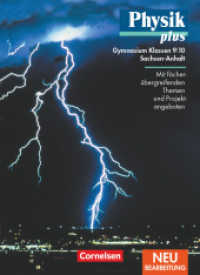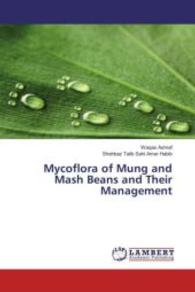- ホーム
- > 洋書
- > 英文書
- > Computer / Operating Systems
Full Description
The Most Useful UNIX Guide for Mac OS X Users Ever, with Hundreds of High-Quality Examples!Beneath Mac OS (R) X's stunning graphical user interface (GUI) is the most powerful operating system ever created: UNIX (R). With unmatched clarity and insight, this book explains UNIX for the Mac OS X user-giving you total control over your system, so you can get more done, faster. Building on Mark Sobell's highly praised A Practical Guide to the UNIX System, it delivers comprehensive guidance on the UNIX command line tools every user, administrator, and developer needs to master-together with the world's best day-to-day UNIX reference.This book is packed with hundreds of high-quality examples. From networking and system utilities to shells and programming, this is UNIX from the ground up-both the "whys" and the "hows"-for every Mac user. You'll understand the relationships between GUI tools and their command line counterparts. Need instant answers? Don't bother with confusing online "manual pages": rely on this book's example-rich, quick-access, 236-page command reference!Don't settle for just any UNIX guidebook. Get one focused on your specific needs as a Mac user!A Practical Guide to UNIX (R) for Mac OS (R) X Users is the most useful, comprehensive UNIX tutorial and reference for Mac OS X and is the only book that deliversBetter, more realistic examples covering tasks you'll actually need to perform Deeper insight, based on the authors' immense knowledge of every UNIX and OS X nook and cranny Practical guidance for experienced UNIX users moving to Mac OS X Exclusive discussions of Mac-only utilities, including plutil, ditto, nidump, otool, launchctl, diskutil, GetFileInfo, and SetFile Techniques for implementing secure communications with ssh and scp-plus dozens of tips for making your OS X system more secure Expert guidance on basic and advanced shell programming with bash and tcsh Tips and tricks for using the shell interactively from the command line Thorough guides to vi and emacs designed to help you get productive fast, and maximize your editing efficiency In-depth coverage of the Mac OS X filesystem and access permissions, including extended attributes and Access Control Lists (ACLs) A comprehensive UNIX glossary Dozens of exercises to help you practice and gain confidence And much more, including a superior introduction to UNIX programming tools such as awk, sed, otool, make, gcc, gdb, and CVS
Contents
Preface xxviiChapter 1The Heritage of Linux: UNIX 5What Is So Good About Linux? 6Overview of Linux 10Additional Features of Linux 15Chapter Summary 16Exercises 17Part I: The Linux Operating System 19Chapter 2: Getting Started 21Conventions Used in This Book 22Logging In 24Working with the Shell 25Curbing Your Power: Superuser Access 28Getting the Facts: Where to Find Documentation 29More About Logging In 35Chapter Summary 38Exercises 39Advanced Exercises 39Chapter 3: Command Line Utilities 41Special Characters 42Basic Utilities 43Working with Files 45| (Pipe): Communicates Between Processes 52Four More Utilities 53Compressing and Archiving Files 56Locating Commands 61Obtaining User and System Information 63Communicating with Other Users 67Email 69Chapter Summary 69Exercises 72Advanced Exercises 73Chapter 4: The Linux Filesystem 75The Hierarchical Filesystem 76Directory and Ordinary Files 77Working with Directories 88Access Permissions 91Links 96Chapter Summary 102Exercises 103Advanced Exercises 105Chapter 5: The Shell 107The Command Line 108Standard Input and Standard Output 113Running a Program in the Background 125Filename Generation/Pathname Expansion 127Builtins 132Chapter Summary 133Exercises 134Advanced Exercises 136Part II: The Editors 137Chapter 6: The vim Editor 139History 140Tutorial: Creating and Editing a File with vim 141The compatible Parameter 148Introduction to vim Features 148Command Mode: Moving the Cursor 154Input Mode 158Command Mode: Deleting and Changing Text 160Searching and Substituting 164Miscellaneous Commands 170Yank, Put, and Delete Commands 171Reading and Writing Files 174Setting Parameters 175Advanced Editing Techniques 180Units of Measure 184Chapter Summary 188Exercises 193Advanced Exercises 194Chapter 7: The emacs Editor 195History 196Tutorial: Getting Started with emacs 198Basic Editing Commands 204Online Help 209Advanced Editing 212Language-Sensitive Editing 225Customizing emacs 235More Information 240Chapter Summary 241Exercises 248Advanced Exercises 250Part III: The Shells 253Chapter 8: The Bourne Again Shell 255Background 256Shell Basics 257Parameters and Variables 277Processes 292History 295Aliases 312Functions 315Controlling bash Features and Options 318Processing the Command Line 322Chapter Summary 332Exercises 334Advanced Exercises 336Chapter 9: The TC Shell 339Shell Scripts 340Entering and Leaving the TC Shell 341Features Common to the Bourne Again and TC Shells 343Redirecting Standard Error 349Working with the Command Line 350Variables 355Control Structures 368Builtins 377Chapter Summary 381Exercises 382Advanced Exercises 384Part IV: Programming Tools 385Chapter 10: Programming Tools 387Programming in C 388Using Shared Libraries 396make: Keeps a Set of Programs Current 399Debugging C Programs 407Threads 417System Calls 417Source Code Management 420Chapter Summary 430Exercises 431Advanced Exercises 432Chapter 11: Programming the Bourne Again Shell 435Control Structures 436File Descriptors 470Parameters and Variables 474Builtin Commands 487Expressions 501Shell Programs 510Chapter Summary 520Exercises 522Advanced Exercises 524Chapter 12: The gawk Pattern Processing Language 527Syntax 528Arguments 528Options 529Notes 529Language Basics 530Examples 537Advanced gawk Programming 554Error Messages 559Chapter Summary 560Exercises 561Advanced Exercises 561Chapter 13: The sed Editor 563Syntax 564Arguments 564Options 564Editor Basics 565Examples 568Chapter Summary 578Exercises 579Part V: Command Reference 581Standard Multiplicative Suffixes 586Common Options 587The sample Utility 587sample: Very brief description of what the utility does 588aspell: Checks a file for spelling errors 589at: Executes commands at a specified time 593bzip2: Compresses or decompresses files 596cal: Displays a calendar 598cat: Joins and displays files 599cd: Changes to another working directory 601chgrp: Changes the group associated with a file 603chmod: Changes the access mode (permissions) of a file 604chown: Changes the owner of a file and/or the group the file is associated with 608cmp: Compares two files 610comm: Compares sorted files 612configure: Configures source code automatically 614cp: Copies files 616cpio: Creates an archive or restores files from an archive 619crontab: Maintains crontab files 624cut: Selects characters or fields from input lines 627date: Displays or sets the system time and date 630dd: Converts and copies a file 633df: Displays disk space usage 636diff: Displays the differences between two files 638du: Displays information on disk usage by file 644echo: Displays a message 647expr: Evaluates an expression 649file: Displays the classification of a file 653find: Finds files based on criteria 655finger: Displays information about users 661fmt: Formats text very simply 664fsck: Checks and repairs a filesystem 666ftp: Transfers files over a network 671gcc: Compiles C and C++ programs 678grep: Searches for a pattern in files 683gzip: Compresses or decompresses files 688head: Displays the beginning of a file 691kill: Terminates a process by PID 693killall: Terminates a process by name 695less: Displays text files, one screen at a time 697ln: Makes a link to a file 702lpr: Sends files to printers 705ls: Displays information about one or more files 708make: Keeps a set of programs current 715man: Displays documentation for commands 721mkdir: Creates a directory 724mkfs: Creates a filesystem on a device 725Mtools: Uses DOS-style commands on files and directories 728mv: Renames or moves a file 732nice: Changes the priority of a command 734nohup: Runs a command that keeps running after you log out 736od: Dumps the contents of a file 737paste: Joins corresponding lines from files 742pr: Paginates files for printing 744ps: Displays process status 746rcp: Copies one or more files to or from a remote system 750rlogin: Logs in on a remote system 752rm: Removes a file (deletes a link) 753rmdir: Removes a directory 755rsh: Executes commands on a remote system 756scp: Securely copies one or more files to or from a remote system 758sleep: Creates a process that sleeps for a specified interval 760sort: Sorts and/or merges files 762split: Divides a file in into sections 771ssh: Securely executes commands on a remote system 773strings: Displays strings of printable characters 777stty: Displays or sets terminal parameters 778tail: Displays the last part (tail) of a file 783tar: Stores or retrieves files to/from an archive file 786tee: Copies standard input to standard output and one or more files 791telnet: Connects to a remote system over a network 792test: Evaluates an expression 794top: Dynamically displays process status 798touch: Changes a file's access and/or modification time 801tr: Replaces specified characters 804tty: Displays the terminal pathname 807tune2fs: Changes parameters on an ext2 or ext3 filesystem 808umask: Establishes the file-creation permissions mask 810uniq: Displays unique lines 812w: Displays information about system users 814wc: Displays the number of lines, words, and bytes 816which: Shows where in PATH a command is located 817who: Displays information about logged-in users 819xargs: Converts standard input into command lines 821Part VI: Appendixes 825Appendix A: Regular Expressions 827Characters 828Delimiters 828Simple Strings 828Special Characters 828Rules 831Bracketing Expressions 832The Replacement String 833Extended Regular Expressions 834Appendix Summary 835Appendix B: Help 837Solving a Problem 838Finding Linux-Related Information 839Specifying a Terminal 844Appendix C: Keeping the System Up-to-Date 847yum: Updates and Installs Packages 848Apt: An Alternative to yum 850BitTorrent 855Glossary 859Index 913








